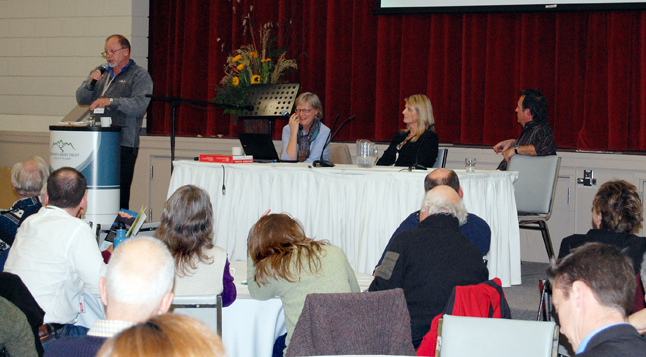By David F. Rooney
Can the different communities of the Columbia Basin really bootstrap themselves into the future? Can they really find common approaches to common problems?
This might sound a little airy-fairy to outsiders, but these are serious questions for the thousands of people whose villages and towns depend on the Columbia Basin Trust for leadership, guidance, assistance and, too, financial assistance.
There are about 174,000 people who call the Basin home and whether you live in Rossland or Revelstoke everyone shares common concerns: loss of young people, the loss of major industries, rising food costs, the loss of agriculture, the need for new approaches to economic development, major demographic change and more — much, much more..
How though should people approach them? Re-invent the wheel from town to town? Or learn from each other and strive to adapt to the challenges that are just now looming on the horizon: technological change, the needs of rapidly aging populations and, whether we’re ready for it or not, racial, cultural and demographic changes on a scale that has probably not been seen in Western Canada since 1900?
These are some of the major questions being considered by about 300 people who have been attending the CBT’s Shaping Our Future Together Symposium at the Revelstoke Community Centre this weekend. This is a major event for the CBT and it has a deep purpose. Whether it will be successful remains to be seen, but it’s first days — Friday and Saturday — were interesting.
Friday afternoon’s activities were the kind of get-to-know-one-another things you’d expect: a mingler and a dinner at Revelstoke Mountain Resort.
But there was serious stuff, too. The Canada-US Columbia River Treaty that resulted in the damming of the Columbia River, the subsequent flooding of our river valleys and the destruction of villages, towns, farms and homes all along its length, is formally due to be renegotiated in 2014. Increasingly, though, there is discussion of simply terminating the agreement and letting everyone go in their own direction. This sounds simple enough, but our homes and towns were burned and then drowned so that the Columbia could be dammed here and American homes, farms and towns protected. The Americans paid British Columbians a settlement for this, but the future of the agreement is now open to question.
As one participant said afterwards: “It’s just like politicians. They start to introduce things and terms like ‘termination’ and then they talk about it more and more. Weasel words.You know how it will end.'”
Well, maybe and maybe not. But it does have a bearing on our communities in one way or another.
Fortunately, the CBT helps mitigate some of the consequences of all that burning and damming. Yes, it took a long time to develop it, but it happened and the CBT does work to benefit the communities that are, in one way or another, dependent upon the Columbia River .
The hundreds of millions of dollars that the province agreed to give the CBT when it was formed almost two decades ago, forms a pool of money that has been invested in hydroelectric power and social and economic development up and down the river’s length in Canada. Think it doesn’t matter here? Then consider the fact that millions of CBT dolars have been invested in community programs and projects in the Revelstoke area alone through just the Community Initiatives Program over the last decade. Ad it doesn’t end there. The CBT provides seed money for a lot of things everywhere, from housing to business advice.
But by itself it cannot overcome the challenges that face all of our communities. That is something that only the self-reliant people of the Basin, who increasingly see themselves locked in an urban-rural divide, can do. That the CBT exists may make it easier to face the future, particularly when it works to build a sense of regional identity and common approaches to common problems.
This story could regurgitate all kinds of facts and comments made by presenters and participants, but I think the best way to do describe the symposium to this point is to tell you about the last hour of Saturday’s formal activities. After hashing out issues in sessions dedicated to 1) Building Smarter Communities Using Broadband; 2) Effective Community and Stakeholder Engagement; 3) Building Strong Organizations for Strong Communities; and 4) Alternate Energy and Energy Sustainability, participants were asked to name the top 20 “drivers” they think will shape the future.
Those things most people thought would most shape the future were: technological change, environmental stewardship; aging populations, climate change, economic development, the increasing urban-rural divide, energy costs, provincial debt, the black windows phenomena, sustainable planning, sustainable agriculture and food security, tourism, collaboration, global economic developments, the wealth gap, the existence of the CBT itself, education, the erosion of cultural organizations, transportation and water.
Everyone rated these issues in terms of their importance. The numbers are being crunched by CBT staff overnight and the results, along with more discussion will emerge at Sunday’s concluding session.
Do you think these are the things that will drive the future?


















